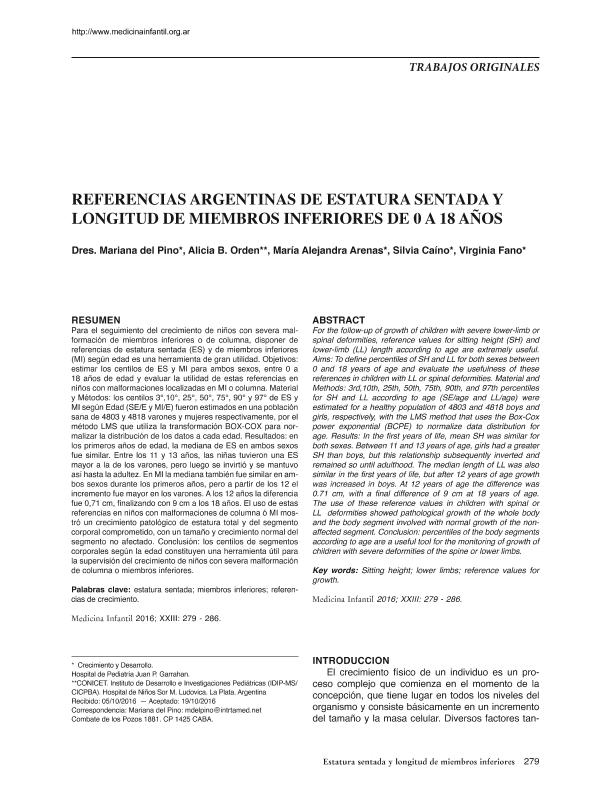Mostrar el registro sencillo del ítem
dc.contributor.author
Del pino, Mariana
dc.contributor.author
Orden, Alicia Bibiana

dc.contributor.author
Arenas, María Alejandra
dc.contributor.author
Caino, Silvia Alejandra

dc.contributor.author
Fano, Virginia
dc.date.available
2019-09-16T20:45:49Z
dc.date.issued
2016-12
dc.identifier.citation
Del pino, Mariana; Orden, Alicia Bibiana; Arenas, María Alejandra; Caino, Silvia Alejandra; Fano, Virginia; Referencias Argentinas de estatura sentada y longitud de miembros inferiores de 0 a 18 años; Fundaciòn Hospital de Pediatría "Prof. Dr. Juan P. Garrahan"; Medicina Infantil; 23; 4; 12-2016; 279-286
dc.identifier.issn
0328-0160
dc.identifier.uri
http://hdl.handle.net/11336/83664
dc.description.abstract
Para el seguimiento del crecimiento de niños con severa malformación de miembros inferiores o de columna, disponer de referencias de estatura sentada (ES) y de miembros inferiores (MI) según edad es una herramienta de gran utilidad. Objetivos: estimar los centilos de ES y MI para ambos sexos, entre 0 a 18 años de edad y evaluar la utilidad de estas referencias en niños con malformaciones localizadas en MI o columna. Material y Métodos: los centilos 3°,10°, 25°, 50°, 75°, 90° y 97° de ES y MI según Edad (SE/E y MI/E) fueron estimados en una población sana de 4803 y 4818 varones y mujeres respectivamente, por el método LMS que utiliza la transformación BOX-COX para normalizar la distribución de los datos a cada edad. Resultados: en los primeros años de edad, la mediana de ES en ambos sexos fue similar. Entre los 11 y 13 años, las niñas tuvieron una ES mayor a la de los varones, pero luego se invirtió y se mantuvo así hasta la adultez. En MI la mediana también fue similar en ambos sexos durante los primeros años, pero a partir de los 12 el incremento fue mayor en los varones. A los 12 años la diferencia fue 0,71 cm, finalizando con 9 cm a los 18 años. El uso de estas referencias en niños con malformaciones de columna ó MI mostró un crecimiento patológico de estatura total y del segmento corporal comprometido, con un tamaño y crecimiento normal del segmento no afectado. Conclusión: los centilos de segmentos corporales según la edad constituyen una herramienta útil para la supervisión del crecimiento de niños con severa malformación de columna o miembros inferiores.
dc.description.abstract
For the follow-up of growth of children with severe lower-limb or spinal deformities, reference values for sitting height (SH) and lower-limb (LL) length according to age are extremely useful. Aims: To define percentiles of SH and LL for both sexes between 0 and 18 years of age and evaluate the usefulness of these references in children with LL or spinal deformities. Material and Methods: 3rd,10th, 25th, 50th, 75th, 90th, and 97th percentiles for SH and LL according to age (SE/age and LL/age) were estimated for a healthy population of 4803 and 4818 boys and girls, respectively, with the LMS method that uses the Box-Cox power exponential (BCPE) to normalize data distribution for age. Results: In the first years of life, mean SH was similar for both sexes. Between 11 and 13 years of age, girls had a greater SH than boys, but this relationship subsequently inverted and remained so until adulthood. The median length of LL was also similar in the first years of life, but after 12 years of age growth was increased in boys. At 12 years of age the difference was 0.71 cm, with a final difference of 9 cm at 18 years of age. The use of these reference values in children with spinal or LL deformities showed pathological growth of the whole body and the body segment involved with normal growth of the nonaffected segment. Conclusion: percentiles of the body segments according to age are a useful tool for the monitoring of growth of children with severe deformities of the spine or lower limbs.
dc.format
application/pdf
dc.language.iso
spa
dc.publisher
Fundaciòn Hospital de Pediatría "Prof. Dr. Juan P. Garrahan"
dc.rights
info:eu-repo/semantics/openAccess
dc.rights.uri
https://creativecommons.org/licenses/by-nc-sa/2.5/ar/
dc.subject
Estatura Sentada
dc.subject
Miembros Inferiores
dc.subject
Referencias de Crecimiento
dc.subject.classification
Medicina Critica y de Emergencia

dc.subject.classification
Medicina Clínica

dc.subject.classification
CIENCIAS MÉDICAS Y DE LA SALUD

dc.title
Referencias Argentinas de estatura sentada y longitud de miembros inferiores de 0 a 18 años
dc.type
info:eu-repo/semantics/article
dc.type
info:ar-repo/semantics/artículo
dc.type
info:eu-repo/semantics/publishedVersion
dc.date.updated
2019-05-23T19:11:39Z
dc.journal.volume
23
dc.journal.number
4
dc.journal.pagination
279-286
dc.journal.pais
Argentina

dc.journal.ciudad
Ciudad Autónoma de Buenos Aires
dc.description.fil
Fil: Del pino, Mariana. Gobierno de la Ciudad de Buenos Aires. Hospital de Pediatría "Juan P. Garrahan"; Argentina
dc.description.fil
Fil: Orden, Alicia Bibiana. Consejo Nacional de Investigaciones Científicas y Técnicas. Centro Científico Tecnológico Conicet - La Plata; Argentina. Provincia de Buenos Aires. Ministerio de Salud. Hospital de Niños "Sor María Ludovica" de La Plata. Instituto de Desarrollo e Investigaciones Pediátricas; Argentina
dc.description.fil
Fil: Arenas, María Alejandra. Gobierno de la Ciudad de Buenos Aires. Hospital de Pediatría "Juan P. Garrahan"; Argentina
dc.description.fil
Fil: Caino, Silvia Alejandra. Consejo Nacional de Investigaciones Científicas y Técnicas. Centro Científico Tecnológico Conicet - La Plata; Argentina. Gobierno de la Ciudad de Buenos Aires. Hospital de Pediatría "Juan P. Garrahan"; Argentina
dc.description.fil
Fil: Fano, Virginia. Gobierno de la Ciudad de Buenos Aires. Hospital de Pediatría "Juan P. Garrahan"; Argentina
dc.journal.title
Medicina Infantil
dc.relation.alternativeid
info:eu-repo/semantics/altIdentifier/url/http://www.medicinainfantil.org.ar/index.php/2016-volumen-xxiii/numero-4
Archivos asociados
